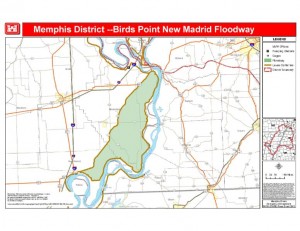For Immediate Release

August 17, 2012
River management issues presented at Corps public hearing in Alton
Alton, IL – Members of the Nicollet Island Coalition (NIC) today called on the Army Corps of Engineers to take decisive and prompt action to protect the Mississippi River from imminent, long-term damage due to poor river management decisions and stem the loss of benefits provided by the river’s floodplains and other natural functions. Today’s meeting was one of several being held along the Mississippi River as members of the Mississippi River Commission and Corps officials conduct their annual low-water inspection of the river.
While this year’s drought has lowered water levels in the river, the certainty of floods in the future has drawn into question the adequacy of current flood control measures. The New Madrid Floodway was operated last year for the first time since 1937 to alleviate flooding at the Mississippi and Ohio Rivers’ confluence. It required the Bird’s Point Levee to be blasted open, unleashing a deluge of water that washed away crops and topsoil and left farm fields, homes, and roads under more than 20 feet of water in some areas.
“The Corps needs to design and construct a more reliable and less damaging system for using the Floodway,” says Brad Walker, Wetlands and Floodplain Director for The Missouri Coalition for the Environment, “because undoubtedly there will be another flood requiring the Floodway to divert excess river flow.” Restoration of the river’s natural floodplains can also help alleviate the need to use the Floodway in the future.
NIC also commented at the public hearing that any reforms related to the Inland Waterways Trust Fund should not only require the navigation industry to make adequate contributions to the Fund but also ensure that taxpayer dollar allocations for Fund activities are made fairly. Monies in the Inland Waterways Trust Fund pay for half the cost of construction and rehabilitation of locks and dams. Since 2008, expenses have exceeded revenue and the Fund is now bankrupt. Currently, taxpayers pay 50% of all lock and dam construction and rehabilitation costs while the navigation industry contributes the other 50%, which amounts to around $80 million annually. All other inland navigation infrastructure costs are paid by taxpayers.
“The Nicollet Island Coalition opposes a recent proposal from the barge industry, H.R. 4342, which shifts more funding for infrastructure costs onto taxpayers,” said Olivia Dorothy, Regional Conservation Coordinator for the Izaak Walton League of America’s Upper Mississippi River Initiative. “Taxpayers already contribute around $800 million annually towards operations, maintenance, planning, construction, and rehabilitation of the inland waterway infrastructure, while industry only contributes around $80 million annually for lock and dam construction and rehabilitation. H.R. 4342 calls for taxpayers to take on the full cost of rehabilitation and dam construction, increasing taxpayer contributions to at least $1 billion annually while the navigation industry will only increase its contributions to $110 million annually.”
Current principles and guidance for evaluating Corps water resource development projects dates back to 1983. The 2007 Water Resources Development Act directed that this document, commonly called the Principles and Guidelines, be revised to incorporate new knowledge and complexities of water resource projects and their impacts on river ecosystems and natural functions.
“The Council on Environmental Quality’s 2009 draft Principles and Guidelines made some headway in recognizing the need to modernize the previous guidance,” said Cecily Smith, Water Resources Specialist with the Prairie Rivers Network. “However, it still lacks several key elements, such as clear and mandatory decision standards. For example, in selecting a flood control project plan, the Corps should be required to select one that incorporates nonstructural approaches unless they are able to clearly show that such an alternative is impracticable. Without such provisions, future water project planning will lack needed accountability and fail to comply with federal laws requiring the Corps and other federal agencies to protect the Mississippi River from environmental impacts.”
The Nicollet Island Coalition is a group of conservation, taxpayer advocate, and environmental organizations formed in 1994 to address restoration issues on the Upper Mississippi River and provide coordinated advocacy work on Upper Mississippi River issues.
Contact:
Olivia Dorothy, Izaak Walton League of America, 217.390.3658, odorothy at iwla.org
Brad Walker, Missouri Coalition for the Environment 563.209.0522, bwalker at moenviron.org
Cecily Smith, Prairie Rivers Network 217.344.2371, csmith at prairierivers.org
Denny Caneff, River Alliance of Wisconsin, 608.257.2424, dcaneff at wisconsinrivers.org
Christine Favilla, Sierra Club, 618.462.6802, cfavilla10 at sbcglobal.net
***********************************************************************************
Founded in 1922, the Izaak Walton League of America protects America’s outdoors through education, community-based conservation, and promoting outdoor recreation.
The Missouri Coalition for the Environment is Missouri’s independent, citizens environmental organization for clean water, clean air, clean energy, and a healthy environment.
The Prairie Rivers Network is Illinois’ only statewide river protection nonprofit, dedicated to protecting Illinois’ rivers for people, fish and wildlife. The organization is also the Illinois state affiliate of the National Wildlife Federation.
The River Alliance of Wisconsin is a nonprofit river conservation organization devoted to saving the rivers and flowing waters of Wisconsin.
The Sierra Club is America’s oldest and largest grassroots environmental organization. Inspired by nature, they work together to protect our communities and the planet.







